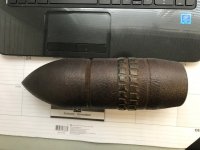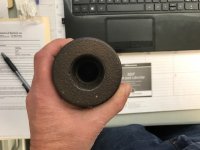You are using an out of date browser. It may not display this or other websites correctly.
You should upgrade or use an alternative browser.
You should upgrade or use an alternative browser.
Identification Help for a Artillery projectile
- Thread starter crcnance
- Start date
2ndsojourn
New member
What are the dimensions? The standard Howitzer was 155mm but there was a lighter 105mm used in WW2.
Do you know where it was originally recovered from? That might help narrow it down some.
One thing of note: Being it's 120mm class, it is possible that it is a naval round. The British had several variants of the 4.7" / 40 Elswick gun which were also used by the Japanese, Italians, and even the US in limited quantities and spanned quite a few years of use..
Ed: measure carefully as there is one possibility that I found that looks similar to that shell...it is 122 mm.
One thing of note: Being it's 120mm class, it is possible that it is a naval round. The British had several variants of the 4.7" / 40 Elswick gun which were also used by the Japanese, Italians, and even the US in limited quantities and spanned quite a few years of use..
Ed: measure carefully as there is one possibility that I found that looks similar to that shell...it is 122 mm.
Last edited:
No clue as to where it came from other than it was bought at a auction. I've got a good set of calipers that I'll use this morning to get more exact measurements and post. Thanks for all of the replies. In the pictures the back side our botail has a threaded recess which leads me to believe it had a rear fuse of some sort the double set of rifle lands are also something I haven't seen which makes me think it's ww2 era and no earlier. As I mentioned before the only stamps visible are AO. They are inline of each other and I'll try to get a good picture of them also.
Well 10.5 inches around, or circumference divided by Pi 3.14 equals 3.34 inches.
10.5 inches/3.14=3.34 inches in diameter.
25.4mm per inch so 3.34 inches*25.4 mm/inch or about 85 mm.
I guess I should have double check my math!
Armed_Chicagoan
New member
Does the rifling on the shell indicate it was meant for a smooth bore gun? Like a giant rifled slug?
Does the rifling on the shell indicate it was meant for a smooth bore gun? Like a giant rifled slug?
NO. Not in this case. The "rifling" on a rifled slug is to allow the slug to compress and pass through any choke.
The artillery projectile here has "driving bands" to take the rifling and spin the projectile, while the rest of it is smaller than full bore diameter, to reduce pressure and give higher velocity.
there are a number of guns in the approximately 5" range, both land and naval artillery. I note that there doesn't seem to be a nose fuse. This could indicate the projectile was AP (shot), or that it was a training/practice round.
Right now, there isn't enough info to make anything more than a wild guess.
Russian 85mm AP shell
2nd from right
3rd from top
This will give you a starting place for more research.
Edit to add: See post 3 at this link for dimensions of the projectile. Linkaruskie
Post 13 for pic of loaded round.
2nd from right
3rd from top
This will give you a starting place for more research.
Edit to add: See post 3 at this link for dimensions of the projectile. Linkaruskie
Post 13 for pic of loaded round.
Last edited:
Jim Watson
New member
If an 85mm Rusky as the pictures indicate, it is AP with a small explosive charge.
Look at the bottom and see if there is a cavity or a plug or a (shudder) fuze.
The bands are engraved which means it has been fired but did not explode. Either practice without charge or a dud. For now.
Look at the bottom and see if there is a cavity or a plug or a (shudder) fuze.
The bands are engraved which means it has been fired but did not explode. Either practice without charge or a dud. For now.
Jim Watson
New member
Phew.
I could not get that first set of pictures to come up and had not seen the open base cavity.
I could not get that first set of pictures to come up and had not seen the open base cavity.
Kevin Rohrer
New member
Definitely an AP round.
The 85mm bore size was used in WWII Soviet artillery, tank guns and AA guns. There was probably a naval gun in that bore size as well, but that's not an area I am very familiar with.
Being a "Standard" Soviet bore size, the projectile in question could have come from ANY nation that used Soviet designs, and calibers. Which includes, directly all nations of the former Warsaw Pact, and all nations supplied by Communist China or the Soviet Union.
And it could date from slightly before WWII or any time since.
Concur on solid (AP) shot with a bursting charge cavity.
That shell could literally have been recovered anywhere east of western Europe, or anywhere in Africa or Asia.
that is IF it's a Soviet 85mm
Where did you measure the diameter??
On the driving bands? or shell body?
if on the shell body, measure on the driving bands and let us know what you get. 88mm?? 90mm??
Sometimes, like with small arms ammo, the actual diameter of the projectile is different from the name of the caliber.
Just as there are .30 caliber rifles all firing the same slug named .303Brit, 7.62x54R Russian and 7.7mm Jap, there are artillery bore sizes all firing the same actual size shells with different names. There were WWII 75mm, 76mm, and 77mm guns, US and British, all firing the same projectiles from different tanks and towed guns. Different cases, but the same projectiles.
It could be a Russian 85mm, but might not be...
Being a "Standard" Soviet bore size, the projectile in question could have come from ANY nation that used Soviet designs, and calibers. Which includes, directly all nations of the former Warsaw Pact, and all nations supplied by Communist China or the Soviet Union.
And it could date from slightly before WWII or any time since.
Concur on solid (AP) shot with a bursting charge cavity.
That shell could literally have been recovered anywhere east of western Europe, or anywhere in Africa or Asia.
that is IF it's a Soviet 85mm
Where did you measure the diameter??
On the driving bands? or shell body?
if on the shell body, measure on the driving bands and let us know what you get. 88mm?? 90mm??
Sometimes, like with small arms ammo, the actual diameter of the projectile is different from the name of the caliber.
Just as there are .30 caliber rifles all firing the same slug named .303Brit, 7.62x54R Russian and 7.7mm Jap, there are artillery bore sizes all firing the same actual size shells with different names. There were WWII 75mm, 76mm, and 77mm guns, US and British, all firing the same projectiles from different tanks and towed guns. Different cases, but the same projectiles.
It could be a Russian 85mm, but might not be...


